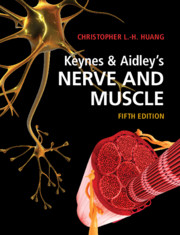Book contents
- Keynes & Aidley’s Nerve and Muscle
- Keynes & Aidley’s Nerve and Muscle
- Copyright page
- Dedication
- Contents
- Preface
- Acknowledgements
- Abbreviations used in the text
- 1 Structural Organisation of the Nervous System
- 2 Resting and Action Potentials
- 3 Background Ionic Homeostasis of Excitable Cells
- 4 Membrane Permeability Changes During Excitation
- 5 Voltage-Gated Ion Channels
- 6 Cable Theory and Saltatory Conduction
- 7 Neuromuscular Transmission
- 8 Synaptic Transmission in the Nervous System
- 9 The Mechanism of Contraction in Skeletal Muscle
- 10 The Activation of Skeletal Muscle
- 11 Excitation–Contraction Coupling in Skeletal Muscle
- 12 Contractile Function in Skeletal Muscle
- 13 Cardiac Muscle
- 14 Ion Channel Function and Cardiac Arrhythmogenesis
- 15 Smooth Muscle
- Further Reading
- References
- Index
12 - Contractile Function in Skeletal Muscle
Published online by Cambridge University Press: 07 November 2020
- Keynes & Aidley’s Nerve and Muscle
- Keynes & Aidley’s Nerve and Muscle
- Copyright page
- Dedication
- Contents
- Preface
- Acknowledgements
- Abbreviations used in the text
- 1 Structural Organisation of the Nervous System
- 2 Resting and Action Potentials
- 3 Background Ionic Homeostasis of Excitable Cells
- 4 Membrane Permeability Changes During Excitation
- 5 Voltage-Gated Ion Channels
- 6 Cable Theory and Saltatory Conduction
- 7 Neuromuscular Transmission
- 8 Synaptic Transmission in the Nervous System
- 9 The Mechanism of Contraction in Skeletal Muscle
- 10 The Activation of Skeletal Muscle
- 11 Excitation–Contraction Coupling in Skeletal Muscle
- 12 Contractile Function in Skeletal Muscle
- 13 Cardiac Muscle
- 14 Ion Channel Function and Cardiac Arrhythmogenesis
- 15 Smooth Muscle
- Further Reading
- References
- Index
Summary
Skeletal muscle contraction can be characterised under either isometric or isotonic conditions of constant length or load. These demonstrate an inverse, Hill, relationship between initial shortening velocity and load. The muscle contraction timecourse exceeds that of its initiating electrical and intracellular Ca2+ changes. Repetitive stimulation consequently produces summation and tetanic fusion of successive muscle twitches. All these variants of contractile activity incur energy expenditure immediately supplied by ATP breakdown, replenished successively from creatine phosphate, carbohydrate and lipid energy supplies. Continued activity leads to energetic depletion, and osmotic and electrolyte imbalances all contributing to fatigue. However, cellular H+ buffering mechanisms mitigate the osmotic and pH effects of the associated lactate production. Na+-K+-ATPase activity buffers the inward Na+ and outward K+ fluxes accompanying electrical activity, and their osmotic effects. Long-term increases in muscle activity exert positive trophic effects. In contrast, ageing is associated with sarcopaenia which contributes importantly to clinical frailty.
Keywords
- Type
- Chapter
- Information
- Keynes & Aidley's Nerve and Muscle , pp. 180 - 199Publisher: Cambridge University PressPrint publication year: 2020



